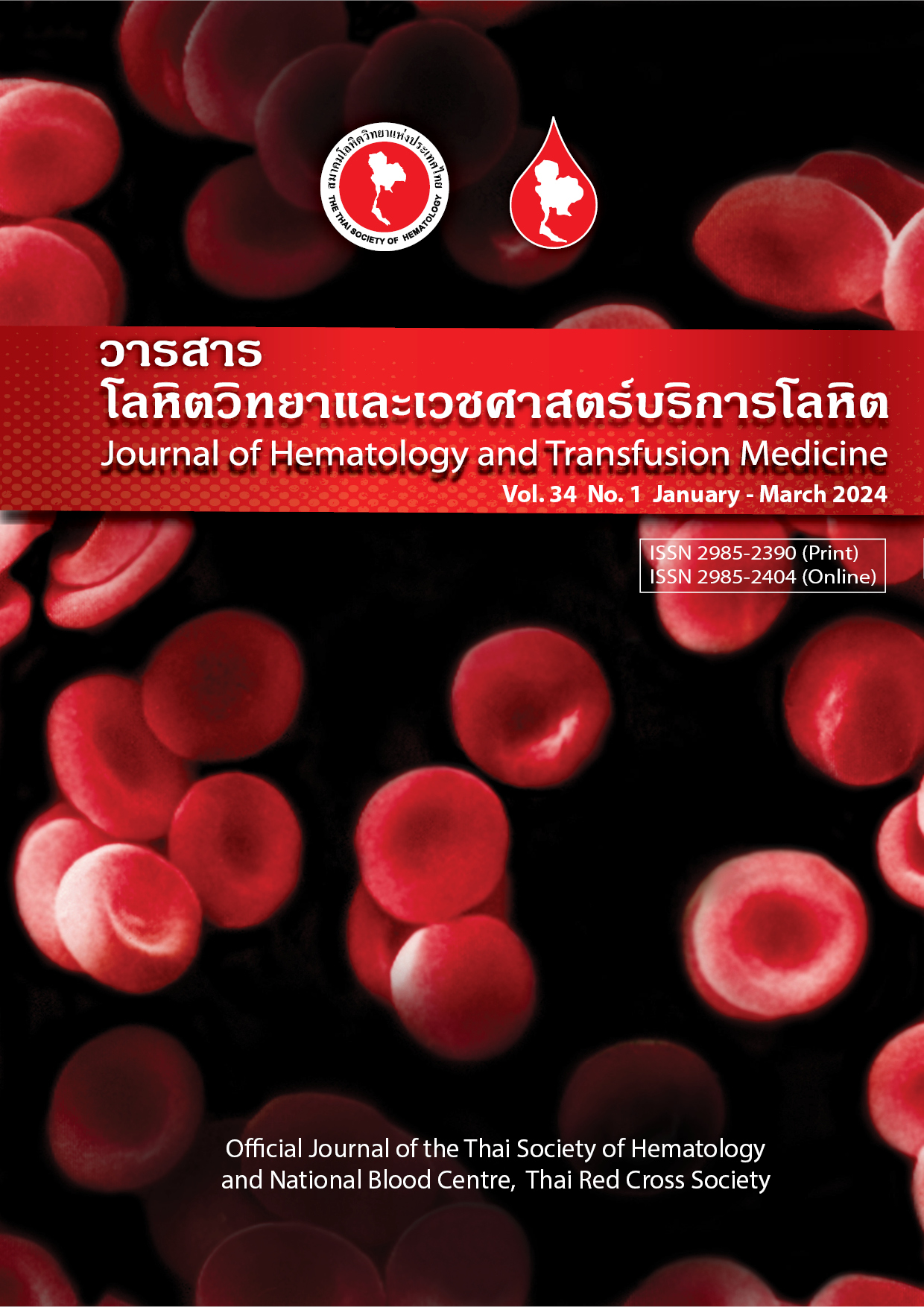Frequency of MNS hybrid glycophorins in Mi(a+) blood donors at the National Blood Centre, Thai Red Cross Society
Keywords:
MNS blood group, Hybrid glycophorins, ไอเอ็ม(เอบวก), หมู่เลือดเอ็มเอ็นเอส, ไฮบริดไกลโคฟอริน, Mi(a )Abstract
Abstract:
Introduction: The MNS hybrid glycophorins represent a group of low frequency antigens associated with MNS blood group system. Mia antigen has various structures which can be classified by the reactions with monospecific antisera in Miltenberger (Mi classes) subsystem. Some MNS hybrid glycophorins are not reactive with anti-Mur which is commonly found in anti-Mia. So, to detect anti-Mur, Mi(a+) red cells should be GP.Mur (Mi.III) or GP.Bun (Mi.VI). Therefore, we carefully selected MNS hybrid glycophorins to produce antibody screening cells and antibody identification panel cells because we found that anti-Mur is the most common antibody in Thais. Objective: To study, characterize and determine the frequency of MNS hybrid glycophorins in Mi(a+) Thai blood donors in order to produce antibody screening cells. Materials and Methods: A total of Mi(a+) 1,216 blood samples from blood donor’s database were phenotyped by using saline standard tube technique with anti-Mur, anti-MUT, anti-Vw and column agglutination technique (Bio-Rad) with anti-Hil, anti-Hop and anti-Hop+anti-Nob (anti-Anek). These mentioned antibodies were kindly supplied by Kanto-Koshinetsu Block Blood Center, Japanese Red Cross, Tokyo, Japan. Results: Phenotyping with a panel of antisera revealed that 1 donor (0.082%), 8 donors (0.658%), 1,122 donors (92.270%), and 74 donors (6.090%) were GP.Vw (Mi.I), GP.Hut (Mi.II), GP.Mur (Mi.III), and GP.Bun (Mi.VI), respectively. A new phenotype, we named from blood donor name GP.Nuk, was identified in 11 blood donors. Conclusion: The study showed that GP.Mur (Mi.III) was the most common MNS glycophorin variants in Mi(a+) Thai blood donors. GP.Vw (Mi.I), GP.Hut (Mi.II), and GP.Bun (Mi.VI) were rare. A novel phenotype, proposed name GP.Nuk, was found in this study. Further studies are required to characterize the structure of the gene that encodes GP.Nuk.
บทคัดย่อ
บทนำ MNS hybrid glycophorins เป็นแอนติเจนหายากที่มีความเกี่ยวข้องกับหมู่โลหิตระบบ MNS แอนติเจน Mia มีโครงสร้างที่หลากหลายสามารถจัดจำแนก โดยใช้การเกิดปฏิกิริยากับ monospecific antisera ในระบบย่อย Miltenberger (Mi classes) แต่บางชนิดไม่เกิดปฏิกิริยากับ anti-Mur ซึ่งพบได้บ่อยใน anti-Mia เพื่อให้ตรวจพบ anti-Mur เม็ดเลือดแดง Mi(a+) ควรจะเป็น GP.Mur (Mi.III) หรือ GP.Bun (Mi.VI) ดังนั้นจึงต้องคัดเลือก Mi(a+) hybrid glycophorins สำหรับนำมาผลิต antibody screening cells อย่างระมัดระวังเพราะ anti-Mur เป็นแอนติบอดีที่พบได้บ่อยในคนไทย วัตถุประสงค์ เพื่อศึกษาลักษณะและหาความถี่ของ Mi(a+) hybrid glycophorins ในผู้บริจาคโลหิตไทย เพื่อทำให้สามารถเลือก Mi(a+) hybrid glycophorins สำหรับการผลิต antibody screening cells วัสดุและวิธีการ ตัวอย่างเลือด Mi(a+) hybrid glycophorins จำนวนทั้งหมด 1,216 ตัวอย่าง จากฐานข้อมูลผู้บริจาคโลหิต ตรวจโดยใช้วิธี standard tube technique กับ anti-Mur, anti-MUT, anti-Vw และวิธี column agglutination technique (BioRad) กับ anti-Hil, anti-Hop และ anti-Hop+anti-Nob (anti-Anek) โดยแอนติบอดีที่กล่าวมานี้ ได้รับความอนุเคราะห์จาก Kanto-Koshinetsu Block Blood Center สภากาชาดญี่ปุ่น กรุงโตเกียว ประเทศญี่ปุ่น ผลการศึกษา ผลการตรวจ phenotyping ด้วยชุดแอนติบอดี พบว่ามี 1 ราย (ร้อยละ 0.082), 8 ราย (ร้อยละ 0.658), 1,122 ราย (ร้อยละ 92.270) และ 74 ราย (ร้อยละ 6.090) เป็น GP.Vw (Mi.I), GP.Hut (Mi.II), GP.Mur (Mi.III) และ GP.Bun (Mi.VI) ตามลำดับ และพบ phenotype ใหม่ ซึ่งขอเสนอชื่อว่า GP.Nuk ตามชื่อผู้บริจาคโลหิตที่พบ จำนวน 11 ราย สรุป การศึกษานี้แสดงให้เห็นว่า GP.Mur (Mi.III) เป็น MNS glycophorin variant ที่พบมากที่สุดในผู้บริจาคโลหิตไทยที่เป็น Mi(a+) ส่วน GP.Vw (Mi.I), GP.Hut (Mi.II) และ GP.Bun (Mi.VI) พบได้ยาก นอกจากนี้ได้พบ phenotype ใหม่ ที่ขอเสนอชื่อว่า GP.Nuk ซึ่งจำเป็นต้องมีการศึกษาลักษณะของ GP.Nuk เพิ่มเติมในระดับโครงสร้างยีน
Downloads
References
Lopez GH, Hyland CA, Flower RL. Glycophorins and the MNS blood group system: a narrative review. Ann Blood. 2021;6:39. doi: 10.21037/aob-21-9.
Fongsarun J, Nuchprayoon I, Yod-in S, Kupatawintu P, Kidprasirt C. Blood groups in Thai blood donors. J Hematol Transfus Med. 2002;12:277-86.
Srijinda S, Bosuwan S, Nuanin C, Suwanasophon C. Anti-Mia and anti-E: the most common clinically significant red cell alloantibodies in patients at Phramongkutklao Hospital. RTA Med J. 2017;70:65-71.
Chandanyingyong D, Pejchandra S. Studies on the miltenberger complex frequency in Thailand and family studies. Vox Sang. 1975;28:152-5.
Bejrachandra S, Nathalang O. Miltenberger subsystem. J Hematol Transfus Med. 2015;25:93-8.
Lopez GH, Emthip M, Suwanwootichai P, Millard GM, Wilson B, Onpuns S, et al. Hemolytic disease of the fetus and newborn caused by anti-sD antibody in a GP.Mur/Mur Thai mother and review of the prevalence of sD in Thai blood donors. Transfusion. 2022;62:2137–42.
Kaset C, Nathalang S, Leetrakool N, Nathalang O. Detection of MNS hybrid molecules (GP.HUT,GP.Mur, GP.Hop, GP.Bun and GP.HF) in central and northern Thai blood donors.
J Hematol Transfus Med. 2015;25:101-6.
Yang MH, Chen JW, Sayaka K, Uchikawa M, Tsuno NH, Wei ST, et al. Universal detection of Mia antigen and frequencies of glycophorin hybrids among blood donors In Taiwan by human monoclonal antibodies against Mia (MNS7), Mur (MNS10), and MUT (MNS35) antigens. Diagnostics. 2021;29:806. doi: 10.3390/diagnostics11050806.
Downloads
Published
Issue
Section
License
Copyright (c) 2024 Journal of Hematology and Transfusion Medicine

This work is licensed under a Creative Commons Attribution-NonCommercial-NoDerivatives 4.0 International License.



